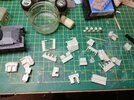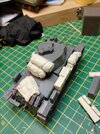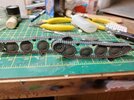- Home
- Forums
- Military Vehicles
- Military Vehicles Under Construction
- Armoured Vehicles Under Constuction
You are using an out of date browser. It may not display this or other websites correctly.
You should upgrade or use an alternative browser.
You should upgrade or use an alternative browser.
A break from RAF stuff with a cuppa 38(t)
- Thread starter KarlW
- Start date
Home safe and sound, time to have a look at this resin stowage.
Plenty there, though it's not all getting used. Legend would have you leave off the stowage bins on the fenders, but I've already glued them in place.
A few of the jerry can handles have broken, I might use the plastic ones from the kit if they fit, I mean all 1/35 jerry cans are the same size, right?
Some casting blocks to remove and some arranging to see what I like them it's time for the paint shop.

Plenty there, though it's not all getting used. Legend would have you leave off the stowage bins on the fenders, but I've already glued them in place.
A few of the jerry can handles have broken, I might use the plastic ones from the kit if they fit, I mean all 1/35 jerry cans are the same size, right?
Some casting blocks to remove and some arranging to see what I like them it's time for the paint shop.

scottie3158
SMF Supporter
That's a tasty looking build mate nicely done.
- Joined
- Apr 28, 2018
- Messages
- 10,864
- Points
- 113
- First Name
- Jakko
Yes, and you might win the lottery too … But at least you can test the jerrycan handlesI mean all 1/35 jerry cans are the same size, right?

Gonna show my ignorance here....
...( and let's be honest, there's plenty of that !! )....
!! )....
But WHY does our resin stuff come on such huge blocks... usually it seems to me that it's a case of "The more delicate the piece... the thicker,(and more difficult to get off without damaging it), we'll make the casting blocks".
... Just my thoughts!!
...( and let's be honest, there's plenty of that
 !! )....
!! )....But WHY does our resin stuff come on such huge blocks... usually it seems to me that it's a case of "The more delicate the piece... the thicker,(and more difficult to get off without damaging it), we'll make the casting blocks".
... Just my thoughts!!
Jim R
SMF Supporter
That resin storage looks very fragile in parts.
Si Benson
SMF Supporter
- Joined
- Apr 27, 2018
- Messages
- 3,326
- Points
- 113
- First Name
- Si
I’m a Complete novice at making resin moulds and castings Mr Smiff……but have been having a dabble nonethelessGonna show my ignorance here....
...( and let's be honest, there's plenty of that!! )....
But WHY does our resin stuff come on such huge blocks... usually it seems to me that it's a case of "The more delicate the piece... the thicker,(and more difficult to get off without damaging it), we'll make the casting blocks".
... Just my thoughts!!

Ive found the block size can help with filling the cavity when pouring the resin and also with demoulding the part.
If your interested there is a this chap on YouTube…..
A lot of the fine jerry can handles are broken out of the bag, most of it is pretty robust though.That resin storage looks very fragile in parts.
Ere,thanks mateI’m a Complete novice at making resin moulds and castings Mr Smiff……but have been having a dabble nonetheless
Ive found the block size can help with filling the cavity when pouring the resin and also with demoulding the part.
If your interested there is a this chap on YouTube

Most interesting,I look forward to having a good look at that tomorrow evening,(going bed shortly as I'm off down to Penzance for work early ,
 )
)Great to hear that you're doing this kinda stuff yourself mate....
... A proper dark horse you are eh?!
You asked for that Andy ! See you should stay on the ground at all times .Oh very Droll!! ..........
........ Doesn`t my Achilles count then?
- Joined
- Apr 28, 2018
- Messages
- 10,864
- Points
- 113
- First Name
- Jakko
Because it’s usually cast in moulds with an opening to pour the resin into. Off the top of my head, I expect that this opening needs to be large enough to easily pour the resin, to supply a reserve of resin as it sinks deeper into the mould (especially during tapping or centrifuging to get rid of air bubbles), and to serve as a large enough handle to remove the finished part from the mould. That last one necessitates a fairly large opening anyway, because resin parts usually come from one-piece moulds, so the whole part needs to go through it — you simply can’t cast the part with a small pour block attached because that would trap the part inside the mould.But WHY does our resin stuff come on such huge blocks...
I think it’s also required to give the poured resin mass and head pressure to force it into all parts of the mould Jakko.Because it’s usually cast in moulds with an opening to pour the resin into. Off the top of my head, I expect that this opening needs to be large enough to easily pour the resin, to supply a reserve of resin as it sinks deeper into the mould (especially during tapping or centrifuging to get rid of air bubbles), and to serve as a large enough handle to remove the finished part from the mould. That last one necessitates a fairly large opening anyway, because resin parts usually come from one-piece moulds, so the whole part needs to go through it — you simply can’t cast the part with a small pour block attached because that would trap the part inside the mould.
- Joined
- Apr 28, 2018
- Messages
- 10,864
- Points
- 113
- First Name
- Jakko
Good point. Though that would be mostly an issue if you’re not using a centrifuge, wouldn’t it? (That said, I have never cast anything in my life except plaster in moulds intended for children, of which I was one at the time  )
)
 )
)Not sure resin is cast in centrifuges. I know white metal is, but not sure about resin. I’ve not had a huge amount to do with resin, but don’t remember mould lines, so am not sure if they use traditional two part centrifuge moulds.Good point. Though that would be mostly an issue if you’re not using a centrifuge, wouldn’t it? (That said, I have never cast anything in my life except plaster in moulds intended for children, of which I was one at the time)
- Joined
- Apr 28, 2018
- Messages
- 10,864
- Points
- 113
- First Name
- Jakko
AFAIK it’s mostly cast in one-piece moulds, which may or may not be a legacy of Verlinden doing that since the early 80s or so and everybody else following his example  But I’d imagine they would want to get the air bubbles out, so maybe a different style of centrifuge that doesn’t take flat, round moulds?
But I’d imagine they would want to get the air bubbles out, so maybe a different style of centrifuge that doesn’t take flat, round moulds?
 But I’d imagine they would want to get the air bubbles out, so maybe a different style of centrifuge that doesn’t take flat, round moulds?
But I’d imagine they would want to get the air bubbles out, so maybe a different style of centrifuge that doesn’t take flat, round moulds?Vacuum chamber to get the bubbles out of the silicone when making the mould.AFAIK it’s mostly cast in one-piece moulds, which may or may not be a legacy of Verlinden doing that since the early 80s or so and everybody else following his exampleBut I’d imagine they would want to get the air bubbles out, so maybe a different style of centrifuge that doesn’t take flat, round moulds?
Then pressure chamber for the casting process to shrink the bubbles in the resin before it cures.
Without the vacuum chamber part any bubbles in the mould will collapse and deform the mould during the pressure chamber stage.
I've only cast resin in open moulds to make wargames bases and some bocage scenery. I did consider going more complex, and start selling, for a while and have some parts I sourced for a vacuum chamber in the shed.
Been playing with stowage, not much bench time this weekend.
Decided to ditch the resin jerrycans as the plastic ones are just a bit crisper, and believe it or not they're both the same size......so the plastic handles would of fit the resin cans nicely.
Removed one of the built in stowage bins just to add more interest.
Next up seeing if I can remove the track assemblies before painting.

Actually, yes I can get the tracks off, quicker than the picture above could upload too.

Decided to ditch the resin jerrycans as the plastic ones are just a bit crisper, and believe it or not they're both the same size......so the plastic handles would of fit the resin cans nicely.
Removed one of the built in stowage bins just to add more interest.
Next up seeing if I can remove the track assemblies before painting.

Actually, yes I can get the tracks off, quicker than the picture above could upload too.


